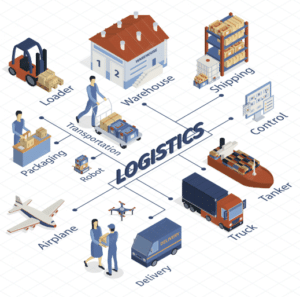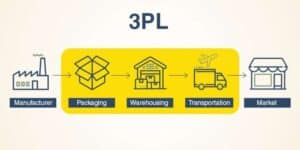When it comes to moving goods across the supply chain, a critical link is the short-haul segment known as drayage. Far from being a simple truck ride, drayage is the specialized, crucial bridge that connects major international transport modes—ocean, air, and rail—to inland distribution networks.
For Canadian businesses, from importers in Vancouver to manufacturers in the Greater Toronto Area (GTA) and distributors in Montreal, efficient drayage is non-negotiable for supply chain speed, cost management, and customer satisfaction.
🚛 What Exactly is Drayage? The Core Definition
Drayage is a specific type of freight transportation that involves the movement of shipping containers or cargo over short distances, typically by specialized truck.
This movement usually occurs within the same geographical or metropolitan area, acting as the vital first or last mile for the container:
- From a Port/Terminal: Moving a container from a marine terminal (like the Port of Vancouver or Port of Halifax) or a rail yard (like a CN or CPKC terminal) to a nearby warehouse or distribution center.
- To the Next Mode: Transferring cargo from one transport hub to another, such as from a rail ramp to a truck for the final delivery, or to a different carrier’s facility.
In essence, drayage ensures goods transition smoothly between transportation modes, preventing costly bottlenecks at Canada’s major trade gateways.
🌟 Why Drayage is Essential to the Canadian Supply Chain
Drayage is more than just transportation; it’s a lynchpin for global trade, especially in a country as geographically diverse and trade-reliant as Canada.
- Bridging Intermodal Transport: It is the key enabler of intermodal shipping, allowing cargo to move seamlessly from container ships to rail cars, and from rail cars to trucks, optimizing for speed and cost across long distances (e.g., from Asia via Vancouver’s ports and then across the country by rail).
- Combating Congestion & Costs: Rapid drayage movements clear containers from crowded port and rail terminals quickly. This action is crucial for avoiding costly demurrage (fees for containers left too long at the terminal) and detention (charges for holding the carrier’s equipment too long).
- Facilitating Trade: The efficiency of drayage directly impacts the overall speed and reliability of getting imports to market and Canadian exports to the world, supporting key corridors like the Pacific Gateway and Asia-North America trade.
🗂️ Key Types of Drayage Services (Tailored for Canadian Needs)
The logistics industry offers specialized drayage services to meet specific supply chain requirements:
| Drayage Type | Description | Typical Canadian Scenario |
| Port (Pier) Drayage | Moving containers directly from a marine terminal dock to a nearby inland destination. | Picking up a container from the Port of Montreal and delivering it to a distribution center in the city’s South Shore. |
| Inter-Carrier Drayage | Transferring containers between facilities belonging to different carriers (e.g., from one rail company’s yard to another). | Moving a unit from a CN Rail facility to a CPKC rail yard for a different route segment. |
| Intra-Carrier Drayage | Movement of containers within the network of a single carrier (e.g., terminal to terminal, or terminal to warehouse). | Shuttling containers between two different warehouses owned by the same 3PL in the GTA. |
| Expedited Drayage | High-priority service for time-sensitive or perishable cargo that requires the fastest possible transit. | Urgent delivery of pharmaceuticals or temperature-controlled food products arriving at Toronto Pearson International Airport (YYZ). |
| Shuttle Drayage | Moving excess containers to a temporary holding yard to relieve severe congestion at the main terminal. | Temporary storage of backed-up containers near the Port of Vancouver during a peak shipping season surge. |
| Door-to-Door Drayage | The complete move from the terminal to the final receiver’s facility, often used for direct customer delivery in e-commerce. | Moving an imported container from a rail terminal to a factory in Windsor, Ontario. |
Drayage in 2025: Navigating the Canadian Market Landscape
As an essential sector, the Canadian drayage industry is rapidly evolving, driven by specific market pressures:
1. The Technology Revolution
- Real-Time Visibility: Carriers are heavily investing in Transportation Management Systems (TMS) and mobile apps that provide shippers with GPS-enabled, real-time tracking of their containers from the moment they exit the port gate.
- Appointment & Slot Management: Technology is mitigating congestion by automating the booking of terminal appointments, which is crucial at major hubs like Vancouver and Montreal.
- AI for Optimization: Advanced platforms use Artificial Intelligence (AI) to optimize routes, reduce empty miles (or “deadhead”), and improve the “street turn” process—where a driver picks up an import, drops it off, and immediately picks up an empty container for return.
2. Ongoing Challenges and Resilience
- Infrastructure & Congestion: Major Canadian ports and intermodal hubs continue to manage high volumes, making congestion and chassis availability persistent concerns.
- Driver Shortage: The industry faces a recurring struggle to attract and retain qualified drivers, which tightens capacity and increases costs.
- Regulatory Compliance: Navigating Canadian customs, border procedures (especially with the U.S. under CUSMA), and provincial trucking regulations requires sophisticated administrative and IT systems.
3. Cost Control in a Volatile Environment
Drayage costs are highly dynamic in Canada and require careful budgeting:
| Drayage Cost Component | Description and 2025 Context |
| Line Haul Rate | The base cost for the distance travelled. Highly variable based on the distance from major terminals in cities like Toronto, Montreal, or Calgary. |
| Fuel Surcharge (FSC) | A variable fee that fluctuates with national diesel prices. A major cost factor in Canada’s vast geography. |
| Chassis Usage Fee | A daily rental fee for the specialized trailer (chassis) needed to move the container. Essential equipment that can be subject to shortages. |
| Demurrage & Detention | Penalties for delays. Demurrage (at the terminal) and Detention (for holding the truck/chassis) are the most significant and avoidable hidden costs. |
| Congestion/Appointment Fees | Surcharges applied by carriers to account for excessive wait times at congested terminals, particularly at peak hours. |
| Yard Pull (Pre-Pull) Fee | Cost to take a container out of the terminal early and store it in a secure yard to avoid impending demurrage fees. |
How to Achieve Seamless Drayage in Canada
For shippers and logistics managers, mastering drayage is key to a cost-effective and reliable supply chain:
- Secure Capacity Early: Book your drayage carrier immediately upon vessel/rail arrival notification, especially in high-demand Canadian corridors (GTA, Vancouver).
- Prioritize Visibility: Partner with carriers that offer real-time GPS tracking and instant Proof of Delivery (POD) to monitor timelines and avoid costly surprises.
- Proactive Fee Management: Set clear contracts that define free time, per-diem rates, and demurrage responsibilities. Use pre-pull services if terminal wait times risk incurring high charges.
- Coordinate with Warehousing: Ensure your warehouse has sufficient manpower and dock space to unload containers immediately upon arrival, minimizing driver detention time.







